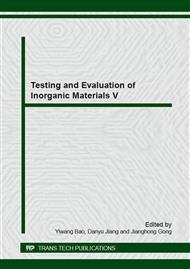p.336
p.340
p.344
p.348
p.352
p.357
p.362
p.366
p.370
Surface Properties of Dental 3Y-TZP with Different Treatments
Abstract:
The purpose of this study was to study the surface characteristics of the dental 3Y-TZP (3 mol% yttria stabilized tetragonal zirconia) ceramic treated by machining process and analysis what impact on the mechanical properties of the 3Y-TZP dental restorations. Dense core ceramic discs were made of 3Y-TZP. The samples were partially sintered to get part strength after uniaxial pressure moulding. The partially sintering green body could be treated by grinding, incising and milling and incising to simulate the CAD-CAM (computer aided design/computer aidedmanufacturing) process in dentistry. The partially sintering samples were then sintered to achieve full density. The dense sintered ceramics were also treated by grinding and incising to simulate the dental restorations adjusting process in dental clinic. The both surface of thespecimens were studied with an optical microscope and field emission SEM. Bulges were observed on the surface of the sample after uniaxial pressure moulding process. The defects due to partially sintered green body milling process were different from incising process in size and shape. Groves are observed on the surfaces of the samples after grinding process. The conclusions were that (i) machining of the final sintered dental 3Y-TZP ceramic brought more critical damage than the machining of partly-sintered green-bodies; (ii) the milling process ofthe partially sintered green-body brought less damage to the 3Y-TZP samples than the incising process.
Info:
Periodical:
Pages:
352-356
Citation:
Online since:
November 2014
Authors:
Keywords:
Price:
Сopyright:
© 2015 Trans Tech Publications Ltd. All Rights Reserved
Share:
Citation:


